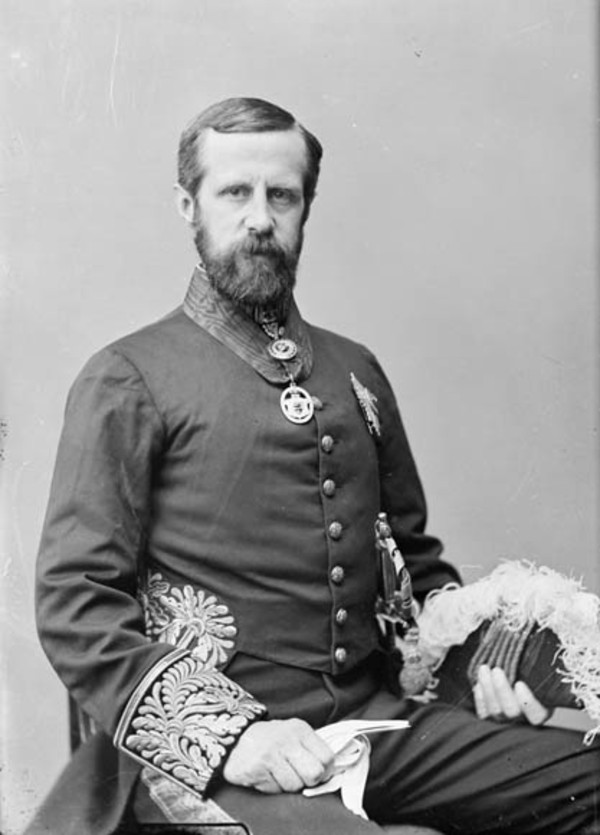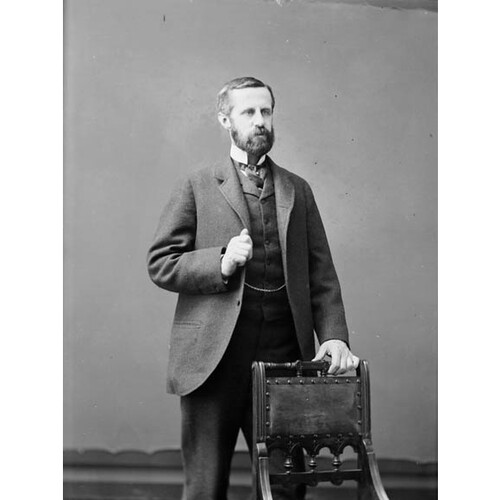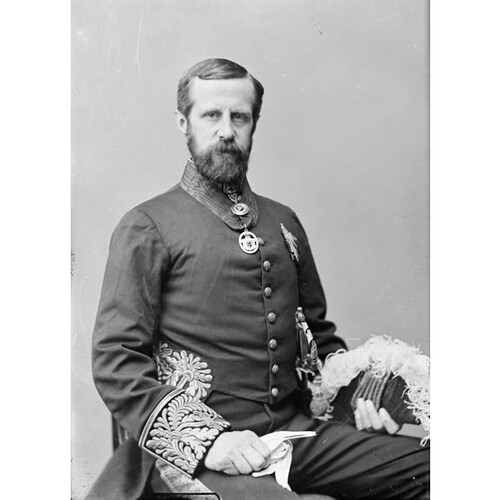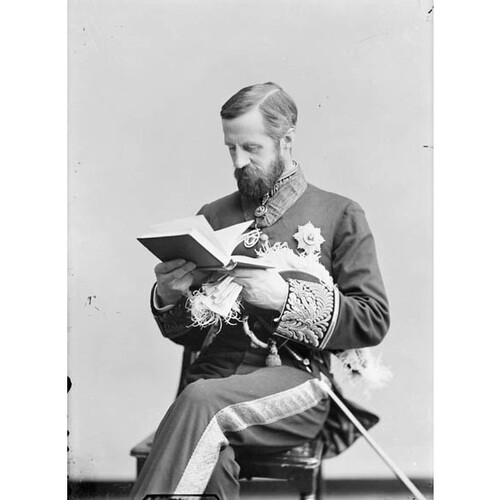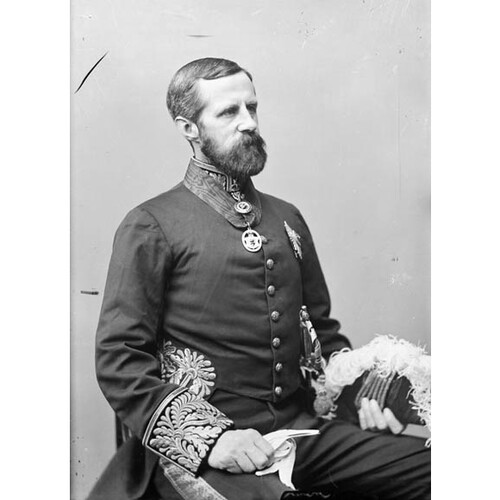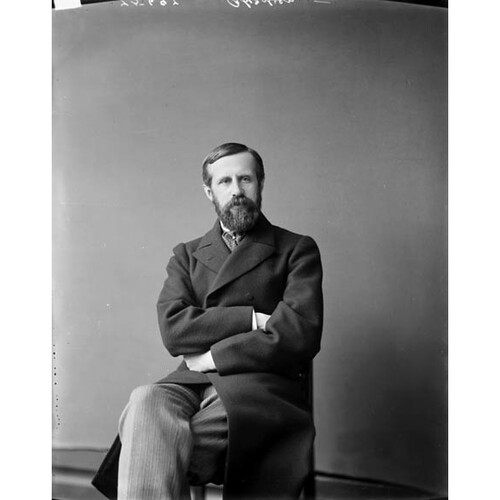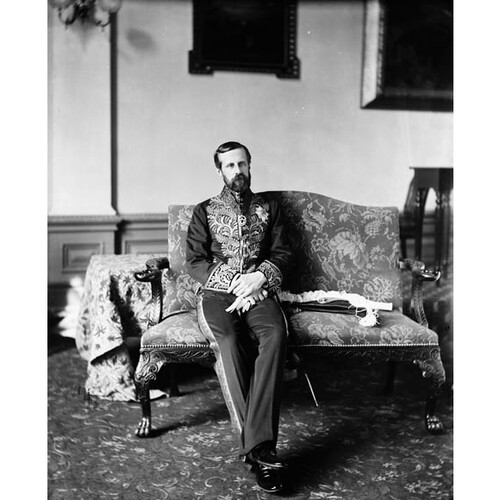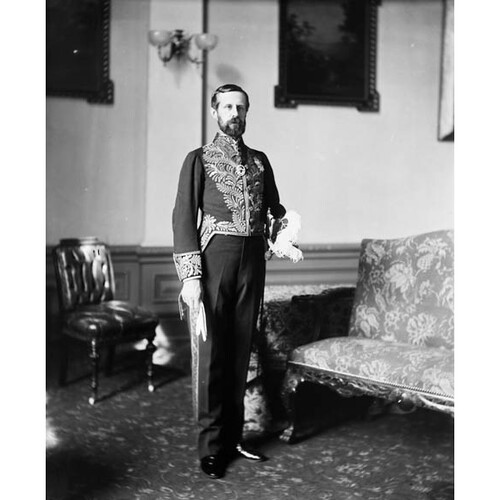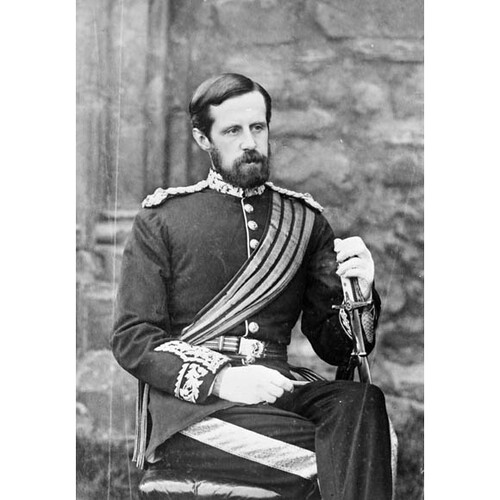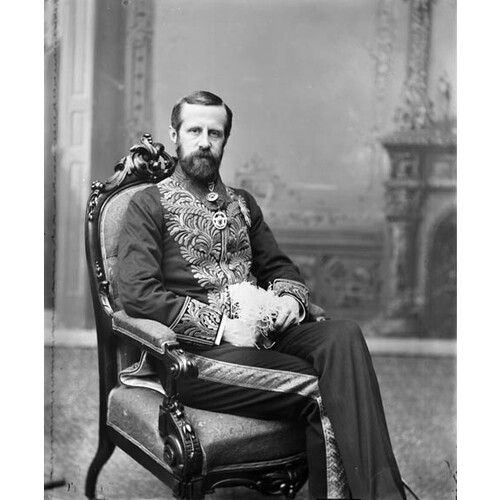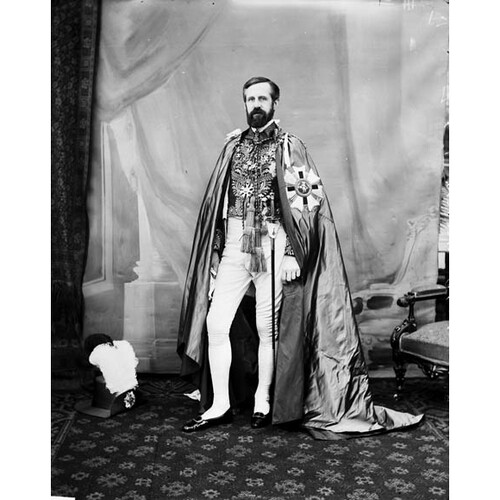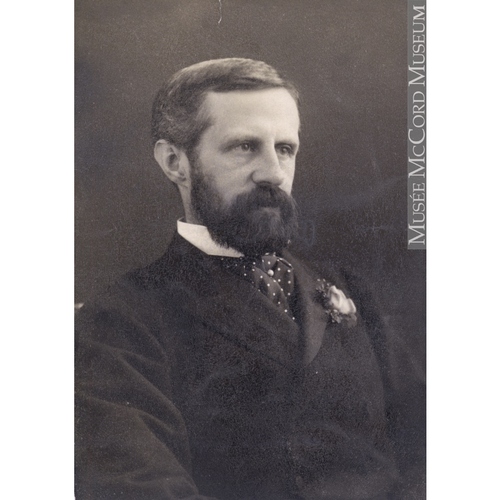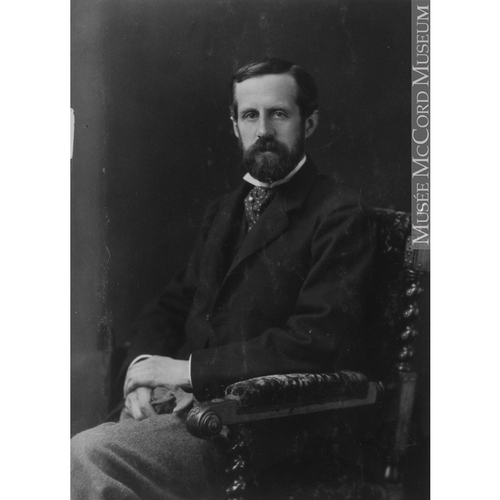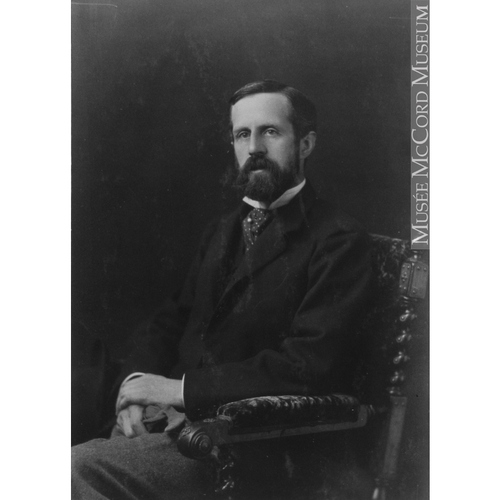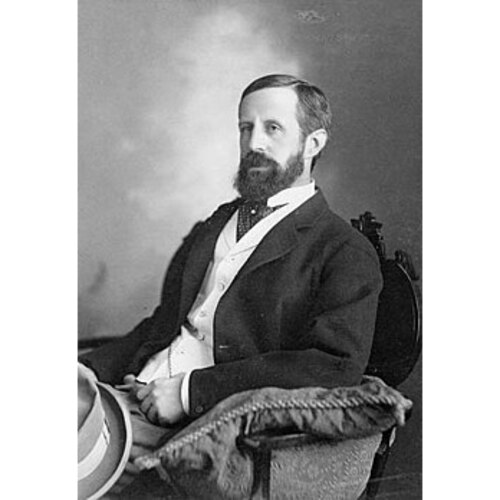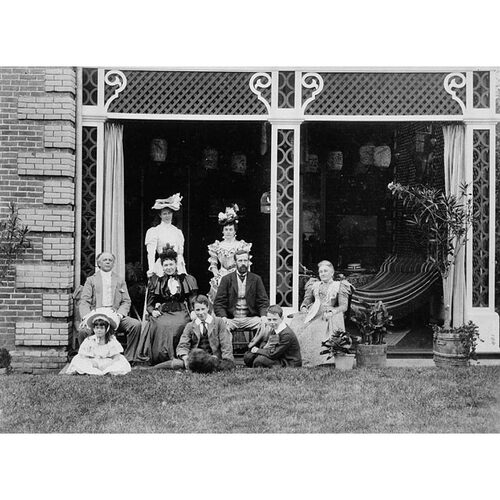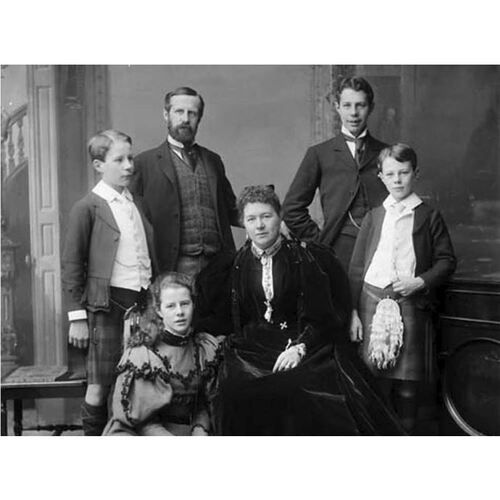HAMILTON-GORDON (Gordon), JOHN CAMPBELL, 7th Earl of ABERDEEN and 1st Marquess of ABERDEEN and TEMAIR, farmer, stockbreeder, horticulturist, governor general, and author; b. 3 Aug. 1847 in Edinburgh, youngest son of George John James Hamilton-Gordon, 5th Earl of Aberdeen, and Mary Baillie; m. 7 Nov. 1877 Ishbel Maria Marjoribanks in London, England, and they had three sons and two daughters, one of whom died in infancy; d. 7 March 1934 at the House of Cromar, Aberdeenshire, Scotland, and was buried in the family cemetery at Haddo House, Aberdeenshire.
Born into a politically prominent family, John Hamilton-Gordon inherited significant expectations for a role in public life. His paternal grandfather, a Conservative, had been prime minister of Great Britain during the disastrous Crimean War. Though long suffering from ill health, John’s father sat as Liberal mp for Aberdeenshire before holding the earldom from 1860 until his death in 1864. He and his wife cultivated strong evangelical and social sympathies in their offspring. The third of their sons, John inherited the family titles and lands after the eldest, George, who had shunned estate duties for service in the American merchant marine, was lost at sea in 1870. The second son, James Henry, had shot himself while at the University of Cambridge two years earlier. The family had lost contact with George, and not until 1872 was John’s succession confirmed by the House of Lords.
By then he had been educated at Cheam School in Surrey, the University of St Andrews, and University College, Oxford, graduating with a ba in modern history and law from Oxford in 1871. He was a good representative of his serious-minded and loving family, early displaying gentle, self-deprecating, tactful, and socially sensitive inclinations. Enthusiastic about science and literature, he, like his grandfather the prime minister, usually had a book ready to hand. From childhood Aberdeen had been fascinated with railways and locomotives, an interest he would retain throughout his life. Though slight in build, he excelled at sports, especially rowing, at university and he was an accomplished horseman. In Canada he would demonstrate his skills in skating and curling and follow hockey and lacrosse with enthusiasm.
At Oxford, Aberdeen was drawn to what was later called the Social Gospel, and its tenets underpinned his commitments as a landlord, philanthropist, and politician. Until his death he would remain a practising and tolerant member of the Church of Scotland. His ecumenism was encouraged by American revivalists Dwight Lyman Moody and Ira David Sankey, who toured Britain in 1873–75; the charismatic Scottish theologian Henry Drummond from 1884 onwards; and eventually the Canadian clergyman and novelist Charles William Gordon (Ralph Connor). Aberdeen’s marriage in 1877 to the decade-younger Ishbel Marjoribanks, daughter of a brewery magnate and Liberal mp with Scottish roots, provided him with emotional and financial support for his progressive inclinations and a family-centred masculinity. As a friend of William Thomas Stead, the muckraking journalist who published a series of sensational articles on juvenile prostitution in the Pall Mall Gazette (London) in 1885, and as a trustee of the reforming White Cross Society, founded two years earlier, Aberdeen emerged as a man committed to personal purity, to what American reformer Frances Elizabeth Caroline Willard would call the “white life for two” (a single standard of morality for men and women), and to the protection of women and children from male abuse.
In the growing conflict between the classes he supported unions and industrial conciliation. These sympathies found expression through his work for two royal commissions set up by the House of Lords, one on railway accidents, to which he was appointed in 1874, and the other on loss of life at sea a decade later. His reforming bent was also apparent at his Haddo estate, where he became northeast Scotland’s most liberal landlord, willing to reduce rents, improve facilities, and subsidize emigration, most often to Canada. The earl idealized that country for the new beginnings it represented to those willing to resettle. The family’s interest in British North America, which had started with the conferral of a Nova Scotia baronetcy in the 17th century, was reinforced when Aberdeen’s uncle Arthur Hamilton Gordon* served as lieutenant governor of New Brunswick in the 1860s.
Perhaps inspired by his mentor, the philanthropist Lord Shaftesbury, Aberdeen sat as a Conservative during his early years in the House of Lords. But he opposed Britain’s acquiescence in Turkey’s suppression of rebel provinces in eastern Europe in the 1870s and his country’s invasion of Afghanistan in 1878. The earl was a proponent of liberal imperialism abroad (which required Britain to lead by superior moral example and foster democracy, unlike the global politics of the Conservatives under Lord Beaconsfield, which was increasingly seen as mere national aggrandizement) and of broadened democracy at home. Further influenced by the Liberal sympathies of his wife and her family, he had by 1880 moved to the other side of the house to become a significant Scottish ally of incoming Liberal prime minister William Ewart Gladstone. The following year Gladstone appointed him lord high commissioner to the General Assembly of the Church of Scotland, a position he held until 1885. Against some opposition, he and the countess used the post to attempt a reconciliation of the established church with the breakaway Free Church of Scotland. Also controversial was Aberdeen’s defence of the right of atheist Charles Bradlaugh to sit in the House of Commons without taking an oath on the Bible. The earl joined other Scottish Liberals in demanding a designated cabinet minister for Scotland and legislation to address the over-centralization of government in London that they believed to be a source of much local discontent.
When, in the mid 1880s, most Scottish aristocrats deserted Gladstone over Home Rule for Ireland, the Aberdeens became crucial to Liberal survival. The reward was the earl’s appointment as lord lieutenant (viceroy) of Ireland in 1886. This position inaugurated the couple’s love for the island and their resulting alienation from many of their class, but Gladstone’s loss in the general election that year cut short Aberdeen’s tenure. In search of roles for liberal aristocrats in an increasingly democratic age, the couple set out in late 1886 on a world tour that would take them to India, Ceylon (Sri Lanka), Australia, New Zealand, and the United States. They became converts to the “commonwealth of nations” foreseen by future Liberal prime minister Lord Rosebery and supporters of closer links between members of the British empire.
In 1890 another lengthy trip overseas brought the Aberdeens and their four children to Canada, where, after stops in Quebec City, Montreal, and Kingston, they lived happily for a time at Highfield House in Hamilton. The couple then crossed the country on the Canadian Pacific Railway, visiting settlers, particularly recent Scottish immigrants, as well as indigenous communities. A return journey to North America in 1891 allowed them to view the ranch in the Kelowna area of British Columbia’s Okanagan valley that they had bought unseen the previous year and named Guisachan after Lady Aberdeen’s Highland home, and to purchase a second, much larger property, Coldstream, near Vernon [see Charles Frederick Houghton*]. Her brother Coutts Marjoribanks, who had been unsuccessful as a cattle rancher in North Dakota, was persuaded to manage Guisachan and then Coldstream before he acquired his own land. The ranches were intended to produce profits in cattle, fruit orchards, and the sale of land to “gentlemen emigrants,” and a jam factory was erected in Vernon. But Lord Aberdeen would prove a poor businessman, and the properties were sold at great loss early in the 20th century. They did, however, replenish the private man and foster his enduring affection for the dominion. In the Vernon area Lord Aberdeen was long remembered as a pioneer of the fruit-growing industry, a keen horseman, and a friendly, albeit rather shy, neighbour.
The couple had hoped to return to Ireland following Gladstone’s electoral victory in 1892, but they were considered too activist-minded. Aberdeen was instead offered, among other positions, the viceroyalty of India or the governor generalship of Canada, to succeed Lord Stanley*, whose term would soon end. The former post, despite its glamour, had little appeal for an aristocrat whose imperial hopes lay with the white settler colonies. The Aberdeens heard of Stanley’s early departure while they were visiting the World’s Columbian exposition in Chicago in the summer of 1893. They arrived at Quebec City on 17 September, and the new governor general was sworn in the following day.
Right from the beginning of his term, Aberdeen set out to heal French–English and Catholic–Protestant conflicts by visiting every region in the country (except the far north), speaking French, and eventually setting up official residences in Halifax, Montreal, Toronto, and Victoria, as well as Quebec City. He positioned himself, the appreciative Montreal mayor Alphonse Desjardins* noted in La Patrie on 27 Sept. 1893, as a champion of “the great and noble principle” of equality between French and English. His broad-minded acceptance of different attitudes and beliefs, evident during his days in the House of Lords, was expressed soon after his arrival. Without mentioning such sectarian organizations as the Protestant Protective Association and the Orange order by name, Aberdeen argued in an early speech in Toronto for a “broad, tolerant and sympathetic spirit” as the true nature of Christianity. He was particularly admiring of individuals such as former Quebec premier Henri-Gustave Joly* de Lotbinière, a francophone Protestant.
The Aberdeens’ openness extended to other religious and ethnic groups as well. In April 1894 they attended Passover eve services at Temple Emanu-El in Montreal [see Samuel Davis*]. The following year saw the governor general inaugurate the Canadian North-West Territorial Exhibition in Regina, which was attended by many indigenous leaders, including Plains Cree chief Payipwat* and Blood chief Red Crow [Mékaisto*]. Aberdeen was made an honorary Blackfoot chief, and the viceregal couple visited the Sarcee Indian Reserve (Alta) [see Chula*]. In October 1896 he was adopted into the Seneca tribe on the Six Nations Reserve near Brantford, Ont.
At the same time his predilection for Scottish traditions affirmed Canada’s ties to the “auld country.” The Aberdeen Cup, donated to the Canadian Golf Association [see George Seymour Lyon] in 1895, served much the same goal. Efforts to assert a common purpose and history were similarly evident in the Aberdeens’ sponsorship of historical pageants in Ottawa, Toronto, and Montreal. While demonstrating a romantic view of indigenous peoples and the resources of the land, these events celebrated the nation’s settler identity, which had begun with incomers from France and the United Kingdom, and future greatness in dominion over all nature (of which indigenous peoples were considered to be a part) from sea to sea. Such exercises in visual imperialism and limited multiculturalism were extremely powerful, offering a counter to the American concept of manifest destiny. Aberdeen’s establishment of the Canadian India Famine Relief Fund in 1897 exemplified his concept of the reciprocal duties of empire.
The Aberdeens had earlier become friends with Conservative prime minister Sir John Sparrow David Thompson* and his wife, Annie Emma Affleck*. Following Thompson’s sudden death in England in December 1894, the governor general faced a cabinet divided by rivalries and conflicting loyalties, with no obvious candidate for leader. The strongest contender, Sir Charles Tupper*, who was serving as high commissioner in London, was disliked by Lord and Lady Aberdeen. Both detested his bombastic political partisanship and his carnal masculinity, which were antithetical to their own sensibilities. The others – George Eulas Foster, John Graham Haggart*, and Sir Charles Hibbert Tupper* – all had drawbacks. So Mackenzie Bowell*, who had been acting prime minister in Thompson’s absence, was invited to discuss the succession with Aberdeen. After further consultation, the governor general asked him to form a government. But unable to hold his cabinet together or to act decisively on the issue of separate schools in Manitoba [see Thomas Greenway*], the maladroit Bowell floundered, provoking a series of crises with which Aberdeen struggled to deal.
Tupper Sr arrived back in Canada in December 1895, and early the following January seven ministers – whom Bowell would characterize as a “nest of traitors” – resigned in protest against the prime minister. The governor general attempted to negotiate, and in the end it was agreed that Tupper would join the government as secretary of state and leader in the House of Commons and that, following dissolution, Bowell would resign and Tupper succeed him. Temporarily appeased, the seven bolters returned to cabinet, and Tupper became prime minister on 1 May. But when a general election was held on 23 June, the Conservatives were trounced by the Liberals under Wilfrid Laurier*. Tupper initially attempted to hold on to his office and drew up a list of senate and other appointments he wished to make. Aberdeen refused to confirm them, however, and Tupper resigned, condemning the governor general for, in his view, acting unconstitutionally. While scholars have censured Aberdeen’s decisions, they have largely absolved him of misconduct. They have been more critical of his and his wife’s obvious Liberal bias and their preference for the more congenial Laurier, whom the couple had long hoped to see in government. Nevertheless, in a letter to the new prime minister in May 1897, the governor general expressed his dislike of the Liberals’ purge of the public service, decrying the Canadian spoils system, which led to civil servants who had been politically active for the Conservatives being summarily dismissed. He argued for a permanent administrative structure free of partisan pressures.
Bowell’s divided cabinet had drawn Aberdeen into another controversy in late 1895. Irish immigrant Francis Valentine Cuthbert Shortis* was facing the death penalty for shooting several employees of the Montreal Cotton Company in Salaberry-de-Valleyfield, Que., the previous March. He had pleaded insanity, and psychiatrists James Vicars Anglin, Charles Kirk Clarke*, Daniel Clark*, and Richard Maurice Bucke* testified in his defence. But he was convicted and sentenced to be hanged on 3 January. A fierce public debate ensued, and petitions were sent to the government asking for clemency. When the cabinet was split equally for and against, the governor general, who was personally opposed to capital punishment, exercised his constitutional prerogative and commuted the sentence to life imprisonment.
Aberdeen received numerous marks of esteem while he was in Canada, including honorary degrees from McGill, Queen’s, Toronto, Ottawa, Laval, and Bishop’s universities, as well as from Princeton and Harvard in the United States. When he decided to cut short his term in late 1898, he left with a considerable sense of accomplishment. The only negative aspect of his tenure was an acceleration in the calumny heaped on him for having a wife whose manifest talent was deemed both too masculine and too feminist. Partisan Conservatives such as the Tuppers remained unforgiving of an imperial representative whom they perceived as Gladstone’s tool and blamed for ushering in their Liberal rivals.
Canada represented Aberdeen’s ideal of liberal imperialism, demonstrating the potential of national and religious accommodation. Back in Britain, alongside such former governors general as lords Lorne [Campbell*] and Derby (formerly Lord Stanley), he endorsed the Imperial Federation League and the Royal Colonial Institute. He also remained a supporter of emigration to Canada, both for Scotland’s crofters and for poor children dispatched by such philanthropists as Thomas John Barnardo and William Quarrier.
Politics in Britain at the end of the century was in turmoil over the South African War. Like many Liberals, Aberdeen criticized British capitalists in the goldfields and condemned concentration camps for Boer women and children. Bloodstained profits and the abuse of prisoners offended his high-minded view of the duties of empire. But he had little sympathy for the Boers, whom he regarded as especially brutal to black Africans and comparatively uncivilized. After the Liberal Party under Sir Henry Campbell-Bannerman won the 1906 general election, Aberdeen returned to Ireland as a viceroy committed to Home Rule and inspired by Canada’s seemingly successful confederation of nationalities. Britain, however, remained deeply divided over the Irish question, and neither Campbell-Bannerman nor his successor, Herbert Henry Asquith, could marshal sufficient support for Home Rule. In Ireland the Aberdeens were considered to have aligned themselves with the nationalists and were boycotted by unionists seeking to retain the British connection, who viewed the couple as traitors to their class. In the increasingly polarized environment, the viceroy became a ready scapegoat for official failure, and Asquith forced him to resign in early 1915. The following year Aberdeen was raised to the rank of marquess, taking the additional title of Temair in honour of his Irish connections. He and his wife spent the years 1915–17 in the United States, and occasionally in Canada, fund-raising for Irish health and children’s causes.
By the end of World War I, Aberdeen, now in his seventies, was more an icon than an activist in liberal circles. In his last years he campaigned for peace and protested the bombing of civilians in Abyssinia (Ethiopia) and Manchuria (People’s Republic of China). He had joined with Lady Aberdeen in publishing a two-volume autobiography, “We twa”: reminiscences … (London, 1925). This gentle defence of the couple’s personal and political loyalties was generously received as testament to a loving and egalitarian marriage that made them the toast of the international feminist movement. His volumes of Scottish jokes were less popular. Aberdeen and his wife had turned over Haddo House to their eldest son in 1920 and established themselves on another property, Cromar, where they lived more modestly, unable to pay the increasingly high taxes and subsidized by their millionaire neighbour Alexander MacRobert and, later, his far less sympathetic widow. The marquess died there in 1934 at the age of 86.
Obituaries mourned Lord Aberdeen as a man better than his times. His career suggests that a few aristocrats could, like the British royal family, humanize government and help to justify elite authority. In that spirit the Globe (Toronto) remembered him as a “friend of every democratic cause,” recalling the suspicion he had generated in the minds of Queen Victoria and King Edward VII for his egalitarian tendencies. The marquess himself would have been especially happy with a Canadian legacy that included Mount Aberdeen in his beloved Rocky Mountains.
In addition to the joint autobiography written with his wife, mentioned in the text, Lord Aberdeen is the author of “The affirmation bill,” Fortnightly Rev. (London), new ser., 33 (April 1883): 475–84; “Union of Presbyterian Churches,” Fortnightly Rev., new ser., 37 (May 1885): 717–24; Tell me another (London, 1925); Jokes cracked by Lord Aberdeen (Dundee, Scot., 1929); and, with Lady Aberdeen, Archie Gordon: an album of recollections of Ian Archibald Gordon (n.p., 1910); The women of the Bible (London, 1927); and More cracks with “we twa” (London, [1929]).
The main collection of Aberdeen papers is held at Haddo House, Aberdeenshire, Scot. The other major group is the John Campbell Hamilton Gordon, 1st Marquess of Aberdeen and Temair fonds (R5319-0-1) at LAC. Additional sources for Lord Aberdeen’s life and career can be found in the author’s Liberal hearts and coronets: the lives and times of Ishbel Marjoribanks Gordon and John Campbell Gordon, the Aberdeens (Toronto, 2015).
Globe, 8 March 1934. Times (London), 8 March 1934. M. A. Banks, Sir John George Bourinot, Victorian Canadian: his life, times, and legacy (Montreal and Kingston, Ont., 2001). Sarah Carter, “‘Your great mother across the salt sea’: prairie First Nations, the British monarchy and the vice regal connection to 1900,” Manitoba Hist. (Winnipeg), no.48 (autumn–winter 2004): 34–48. M. L. Friedland, The case of Valentine Shortis: a true story of crime and politics in Canada (Toronto and London, 1986). Ben Griffin, The politics of gender in Victorian Britain: masculinity, political culture and the struggle for women’s rights (Cambridge, Eng., and New York, 2012). Marjory Harper, Emigration from north-east Scotland (2v., Aberdeen, Scot., 1988). The journal of Lady Aberdeen: the Okanagan valley in the nineties, ed. R. M. Middleton (Victoria, 1986). ODNB. M. A. Ormsby, Coldstream – nulli secundus … (Vernon, B.C., 1990). Marjorie Pentland, A bonnie fechter: the life of Ishbel Marjoribanks, Marchioness of Aberdeen & Temair … 1857 to 1939 (London, 1952). J. T. Saywell, “The crown and the politicians: the Canadian succession question, 1891–1896,” CHR, 37 (1956): 309–37; “Introduction,” in [I. M. Marjoribanks (Hamilton-Gordon), Marchioness of] Aberdeen [and Temair], The Canadian journal of Lady Aberdeen, 1893–1898, ed. J. T. Saywell (Toronto, 1960), xiii–lxxxiv. [W. T. Stead], “Character sketch: Lord and Lady Aberdeen,” Rev. of Reviews (London), 9 (January–June 1894): 132–47 (also available with a slightly different title and pagination as CIHM no.13920). J. T. Watt, “Anti-Catholic nativism in Canada: the Protestant Protective Association,” CHR, 48 (1967): 45–58.
Cite This Article
Veronica Strong-Boag, “HAMILTON-GORDON, JOHN CAMPBELL, 7th Earl and 1st Marquess of ABERDEEN and TEMAIR,” in Dictionary of Canadian Biography, vol. 16, University of Toronto/Université Laval, 2003–, accessed December 26, 2025, https://www.biographi.ca/en/bio/hamilton_gordon_john_campbell_16E.html.
The citation above shows the format for footnotes and endnotes according to the Chicago manual of style (16th edition). Information to be used in other citation formats:
| Permalink: | https://www.biographi.ca/en/bio/hamilton_gordon_john_campbell_16E.html |
| Author of Article: | Veronica Strong-Boag |
| Title of Article: | HAMILTON-GORDON, JOHN CAMPBELL, 7th Earl and 1st Marquess of ABERDEEN and TEMAIR |
| Publication Name: | Dictionary of Canadian Biography, vol. 16 |
| Publisher: | University of Toronto/Université Laval |
| Year of publication: | 2019 |
| Year of revision: | 2019 |
| Access Date: | December 26, 2025 |


